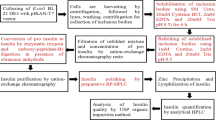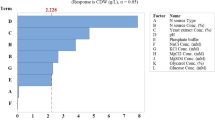Abstract
The optimum conditions for mass production of fusion proinsulin were studied in recombinantEscherichia coli strain BL21 (DE3) [pT7-PI] using fed-batch culture employing pH-stat method. Yeast extract was found to enhance both the growth rate of recombinantE. coli strain BL21 (DE3) [pT7-PI] and its cell mass yield. When the glucose concentration was 10 g/L in the initial medium, 10 g/L concentration of yeast extract was found to be optimal to control the acetate production and to augment both the cell mass yield and the growth rate. Optimum ratio of glucose to yeast extract to minimize the cost of the feeding medium in the fed-batch culture was calculated to be 1.225 and verified by the subsequent experiments. The appropriate inducer concentration and induction time were examined with isopropyl-β-D-thiogalactopyranoside (IPTG). Irrespective of the induction time, IPTG induction resulted in the reduction of growth rate, but the expression level of the fusion protein was maintained at the level of about 20% of the total proteins. Since the volumetric productivity was well maintained in the range between 0.15 and 0.18 g/L.hr at the inducer concentration of above 0.025 mM, the appropriate inducer concentration, in relation to the inducer cost, is considered to be about 0.025 mM.
Similar content being viewed by others
References
Yee, L. and H. W. Blanch (1992) Recombinant trypsin production in high cell density fed-batch cultures inEscherichia coli.Biotechnol. Bioeng. 41: 781–790.
Konstantinov, K., M. Kishimoto, T. Seki, and T. Yoshida (1990) A Balanced DO-stat and its application to the control of acetic acid excretion by recombinantE. coli.Biotechnol. Bioeng. 36: 750–758.
Mori, H., T. Yano, T. Kobayashi, and S. Shimizu (1979) High density cultivation of biomass in fed-batch system with DO-stat.J. Chem. Eng. Japan 12: 313–319.
Mao, W., R. Pan, and D. Freedman (1992) High production of alkaline protease byBacillus lichenifoem is in a fed-batch fermentation using a synthetic medium.J. Ind. Microbiol. 11: 1–6.
Ohta, K., T. Shibui, Y. Morimoto, S. Iijima, and T. Kobayashi (1993) High level production of human proapo A-I by fed-batch culture of recombinantE. coli.J. Ferment Bioeng. 75: 155–157.
Robbins, J. W. and K. B. Taylor (1989) Optimization ofE. coli growth by controlled addition of glucose.Biotechnol. Bioeng. 34: 1289–1294.
Frude, M. J., A. Read, and L. Kennedy (1993) Induction of recombinant protein production by pH stress: A novel glucose feeding strategy.Biotechnol. Lett. 15: 797–802.
Cayuela, C., K. Kai, Y. S. Park, S. Iijima, and T. Kobayashi (1993) Insecticide production by recombinantB. subtilis 1A96 in fed-batch culture with control of glucose concentration.J. Ferment. Bioeng. 75: 383–386.
Park, Y. S., K. Kai, S. Iijima, and T. Kobayashi (1992) Enhanced-galactosidase production by high cell-density culture of recombinantB. subtilis with glucose concentration control.Biotechnol. Bioeng. 40: 686–696.
Vila, P. and A. Villaverde (1993) Inhibition of CI 857-controlled recombinant gene expression inE. coli at very low concentration of glucose.Biotechnol. Lett. 15: 549–552.
Thompson, B. G., M. Kole, and D. F. Gerson (1985) Control of ammonium concentration inE. coli fermentations.Biotechnol. Bioeng. 17: 818–824.
Hopkins, D. J., M. J. Betenbaugh, and P. Dhurjati (1987) Effects of dissolved oxygen shock on the stability of recombinantE. coli containing plasmid pKN401.Biotechnol. Bioeng. 29: 85–91.
Bentley, W. E. and D. S. Kompala (1991) Dynamics of induced CAT expression inE. coli.Biotechnol. Bioeng. 38: 749–760.
Miao, F. and D. S. Kompala (1992) Overex-pression of cloned genes using recombinantE. coli regulated by a T7 promoter: 1. Batch cultures and kinetic modeling.Biotechnol. Bioeng. 40: 787–796.
Studier, F. W. and B. A. Moffatt (1986) Using of bacteriophage T7 RNA polymerase to direct selective high-level expression of cloned genes.J. Mol. Biol. 189: 113–130.
Yoon, S. K., W. K. Kang, and T. H. Park (1994) Fed-batch operation of recombinantE. coli containing trp promoter with controlled specific growth rate.Biotechnol. Bioeng. 43: 995–999.
Yoon, S. K., S. H. Kwon, M. G. Park, W. K. Kang, and T. H. Park (1994) Optimization of recombinantEscherichia coli fed-batch fermentation for bovine somatotropin.Biotechnol. Lett. 16: 1119–1124.
Author information
Authors and Affiliations
Corresponding author
Rights and permissions
About this article
Cite this article
Bae, CS., Hong, MS., Chang, SG. et al. Optimization of fusion proinsulin production by high cell-density fermentation of recombinantE. coli . Biotechnol. Bioprocess Eng. 2, 27–32 (1997). https://doi.org/10.1007/BF02932459
Issue Date:
DOI: https://doi.org/10.1007/BF02932459




